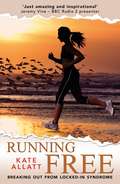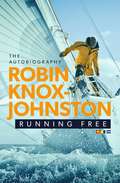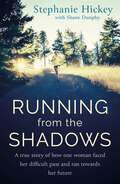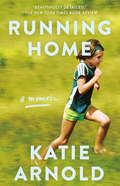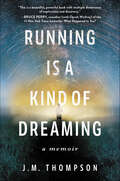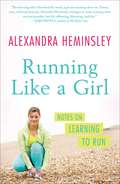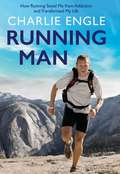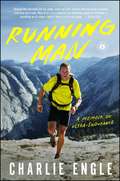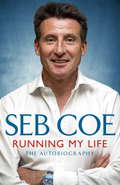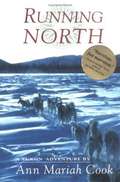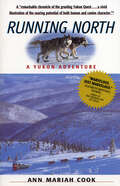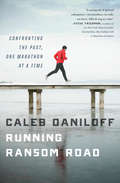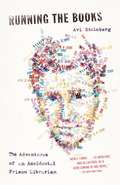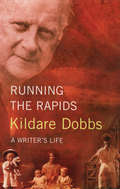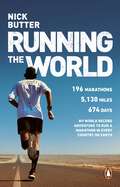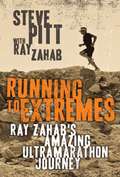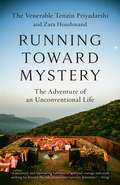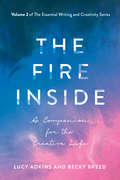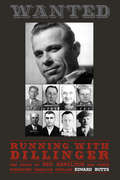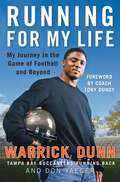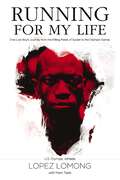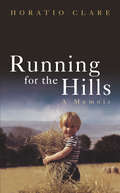- Table View
- List View
Running Free: Breaking Out from Locked-in Syndrome
by Kate Allatt'Just amazing and inspirational' Jeremy VineCan you imagine being trapped inside your own body? Able to see and hear everything going on around you but unable to move or speak - the blink of an eye your only way of communicating.Fell-runner and fun-loving mother-of-three Kate Allatt's life was torn apart when what appeared to be a stress-related headache exploded into a massive brainstem stroke leading to locked-in syndrome. Totally paralysed, she became a prisoner inside her own body. Doctors warned her family she would never walk, talk or swallow or lead a normal life again. But they didn't know Kate. The words no and never were not in her vocabulary.With the help of her best friends and family she drew on every ounce of her runner's stamina and determination to make a recovery that amazed medical experts. Using a letter chart, Kate blinked the words "I will walk again". Soon she was moving her thumb and communicating with the world via Facebook. Eight months after her stroke, Kate said goodbye to nurses, walked out of hospital and returned home to learn how to run again.This is the story of her incredible journey.
Running Free: Breaking Out from Locked-in Syndrome
by Kate Allatt'Just amazing and inspirational' Jeremy VineCan you imagine being trapped inside your own body? Able to see and hear everything going on around you but unable to move or speak - the blink of an eye your only way of communicating.Fell-runner and fun-loving mother-of-three Kate Allatt's life was torn apart when what appeared to be a stress-related headache exploded into a massive brainstem stroke leading to locked-in syndrome. Totally paralysed, she became a prisoner inside her own body. Doctors warned her family she would never walk, talk or swallow or lead a normal life again. But they didn't know Kate. The words no and never were not in her vocabulary.With the help of her best friends and family she drew on every ounce of her runner's stamina and determination to make a recovery that amazed medical experts. Using a letter chart, Kate blinked the words "I will walk again". Soon she was moving her thumb and communicating with the world via Facebook. Eight months after her stroke, Kate said goodbye to nurses, walked out of hospital and returned home to learn how to run again.This is the story of her incredible journey.
Running Free: The Autobiography
by Robin Knox-JohnstonSir Robin Knox-Johnston burst to fame when he became the first man ever to complete a single-handed, non-stop circumnavigation of the world. Now, 50 years on from that famous voyage, he reveals the true, extraordinary story of his life. After leaving school, he immediately joined the Royal Naval Reserve before serving in the merchant navy and travelling the world. During that time, he spied for the British government in the Gulf, worked in the South African dockyards, and built his boat Suhaili in Bombay, before sailing home to England. In June 1968, he set sail in Suhaili in the Sunday Times Golden Globe Race, and Running Free vividly brings to life that remarkable voyage, where he was the only person to finish the race, completing his journey on 22 April 1969 and thus entering the record books. Once back home, he set up a hugely successful business and continued his naval adventures, completing a second solo circumnavigation of the globe in 2007 - at 68, he became the oldest to complete this feat. Knox-Johnston's insatiable appetite for life and adventure shines through these pages, making this book a must for all sailing enthusiasts, readers of books by Ranulph Fiennes and Chris Bonington, or for anyone who has felt that the time for putting up your feet can always be put back to another day.
Running From the Shadows: A true story of how one woman faced her past and ran towards her future
by Stephanie HickeyIn Running from the Shadows Stephanie Hickey tells, in her own words, how she survived abuse at the hands of a trusted family member and of how running, a simple physical activity helped her achieve mindfulness, but also to rediscover love and faith in her body - to reclaim it. Charting her life growing up in the rolling countryside of Waterford in the safety of her beloved family to the moment her childhood was shattered, to the court case where she waived her anonymity, to how she was able to reclaim a sense of herself through the sport which became like a therapy, Running from the Shadows is told with humour, strength and incredible courage -- a book that reveals how, even when things seem at their bleakest, a run through the Irish countryside, can bring you back into the light.
Running From the Shadows: A true story of how one woman faced her past and ran towards her future
by Stephanie HickeyIn Running from the Shadows Stephanie Hickey tells, in her own words, how she survived abuse at the hands of a trusted family member and of how running, a simple physical activity helped her achieve mindfulness, but also to rediscover love and faith in her body - to reclaim it. Charting her life growing up in the rolling countryside of Waterford in the safety of her beloved family to the moment her childhood was shattered, to the court case where she waived her anonymity, to how she was able to reclaim a sense of herself through the sport which became like a therapy, Running from the Shadows is told with humour, strength and incredible courage -- a book that reveals how, even when things seem at their bleakest, a run through the Irish countryside, can bring you back into the light.
Running Home: A Memoir
by Katie ArnoldIn the tradition of Wild and H Is for Hawk, an Outside magazine writer tells her story—of fathers and daughters, grief and renewal, adventure and obsession, and the power of running to change your life.I’m running to forget, and to remember. For more than a decade, Katie Arnold chased adventure around the world, reporting on extreme athletes who performed outlandish feats—walking high lines a thousand feet off the ground without a harness, or running one hundred miles through the night. She wrote her stories by living them, until eventually life on the thin edge of risk began to seem normal. After she married, Katie and her husband vowed to raise their daughters to be adventurous, too, in the mountains and canyons of New Mexico. But when her father died of cancer, she was forced to confront her own mortality. His death was cataclysmic, unleashing a perfect storm of grief and anxiety. She and her father, an enigmatic photographer for National Geographic, had always been kindred spirits. He introduced her to the outdoors and took her camping and on bicycle trips and down rivers, and taught her to find solace and courage in the natural world. And it was he who encouraged her to run her first race when she was seven years old. Now nearly paralyzed by fear and terrified she was dying, too, she turned to the thing that had always made her feel most alive: running. Over the course of three tumultuous years, she ran alone through the wilderness, logging longer and longer distances, first a 50-kilometer ultramarathon, then 50 miles, then 100 kilometers. She ran to heal her grief, to outpace her worry that she wouldn’t live to raise her own daughters. She ran to find strength in her weakness. She ran to remember and to forget. She ran to live. Ultrarunning tests the limits of human endurance over seemingly inhuman distances, and as she clocked miles across mesas and mountains, Katie learned to tolerate pain and discomfort, and face her fears of uncertainty, vulnerability, and even death itself. As she ran, she found herself peeling back the layers of her relationship with her father, discovering that much of what she thought she knew about him, and her own past, was wrong. Running Home is a memoir about the stories we tell ourselves to make sense of our world—the stories that hold us back, and the ones that set us free. Mesmerizing, transcendent, and deeply exhilarating, it is a book for anyone who has been knocked over by life, or feels the pull of something bigger and wilder within themselves. “A beautiful work of searching remembrance and searing honesty . . . Katie Arnold is as gifted on the page as she is on the trail. Running Home will soon join such classics as Born to Run and Ultramarathon Man as quintessential reading of the genre.”—Hampton Sides, author of On Desperate Ground and Ghost Soldiers
Running Is a Kind of Dreaming: A Memoir
by J. M. ThompsonA powerful, breathtaking memoir about a young man's descent into madness, and how running saved his life.“Voluntary or involuntary?” asked the nurse who admitted J. M. Thompson to a San Francisco psychiatric hospital in January 2005. Following years of depression, ineffective medication, and therapy that went nowhere, Thompson feared he was falling into an inescapable darkness. He decided that death was his only exit route from the torture of his mind. After a suicide attempt, he spent weeks confined on the psych ward, feeling scared, alone, and trapped. One afternoon during an exercise break he experienced a sudden urge. “Run, I thought. Run before it’s too late and you’re stuck down there. Right now. Run. ” The impulse that starts with sprints across a hospital rooftop turns into all night runs in the mountains. Through motion and immersion in the beauty of nature, Thompson finds a way out of the hell of depression and drug addiction. Step by step, mile by mile, his body and mind heal. In this lyrical, vulnerable, and breathtaking memoir, J. M. Thompson, now a successful psychologist, retraces the path that led him from despair to wellness, detailing the chilling childhood trauma that caused his depression, and the unorthodox treatment that saved him. Running Is a Kind of Dreaming is a luminous literary testament to the universal human capacity to recover from our deepest wounds.
Running Like a Girl
by Alexandra HeminsleyA charming, hilarious, and practical book about one woman's stumbling, painful efforts to start running and how becoming a runner ultimately transformed her relationships, her body, and her life. In her twenties, Alexandra Heminsley spent more time drinking white wine than she did in pursuit of athletic excellence. When she decided to take up running in her thirties, she had high hopes for a blissful runner's high and immediate physical transformation. After eating three slices of toast with honey and spending ninety minutes on iTunes creating the perfect playlist, she hit the streets--and failed miserably. The stories of her first runs turn the common notion that we are all "born to run" on its head--and exposes the truth about starting to run: it can be brutal. Running Like a Girl tells the story of getting beyond the brutal part, how Alexandra makes running a part of her life, and reaps the rewards: not just the obvious things, like weight loss, health, and glowing skin, but self-confidence and immeasurable daily pleasure, along with a new closeness to her father--a marathon runner--and her brother, with whom she ultimately runs her first marathon. But before her first marathon, she has to figure out the logistics of running: the intimidating questions from a young and arrogant sales assistant when she goes to buy her first running shoes, where to get decent bras for the larger bust, how not to freeze or get sunstroke, and what (and when) to eat before a run. She's figured out what's important (pockets) and what isn't (appearance), and more. For any woman who has ever run, wanted to run, tried to run, or failed to run (even if just around the block), Heminsley's funny, warm, and motivational personal journey from non-athlete extraordinaire to someone who has completed five marathons is inspiring, entertaining, practical, and fun.
Running Man
by Charlie EngleAfter a decade-long addiction to crack cocaine and alcohol, Charlie Engle hit rock bottom after a near-fatal six-day binge ended in a hail of bullets. Then he found running, and it has helped keep him sober, focused and alive. He began to take on the most extreme endurance races, such as the 155-mile Gobi March, and developed a reputation as an inspirational speaker. However, after he made the documentary Running the Sahara, narrated by Matt Damon, which followed him on a 4500-mile crossing of the desert and helped raise $6 million, he was sent to prison after failing to complete his mortgage application properly. It was while he was in jail that he became known as 'The Running Man' as he pounded the prison yard, and soon his fellow inmates were joining him, finding new hope through running. Now, in his brilliantly written and powerful account, Engle tells the story of his life and how running has brought him so much pleasure and peace. Like such classics as Born to Runor Running with the Kenyans, this is a book that anyone who has ever found solace in the freedom of running will enjoy.
Running Man: A Memoir
by Charlie EngleA compulsively readable, remarkably candid memoir from world class ultra-marathon runner Charlie Engle chronicling his globe-spanning races, his record-breaking run across the Sahara Desert, and how running helped him overcome drug addiction...and an unjust stint in federal prison.After a decade-long addiction to crack cocaine and alcohol, Charlie Engle hit bottom with a near-fatal six-day binge that ended in a hail of bullets. As Engle got sober, he turned to running, which became his lifeline, his pastime, and his salvation. He began with marathons, and when marathons weren't far enough, he began to take on ultramarathons, races that went for thirty-five, fifty, and sometimes hundreds of miles, traveling to some of the most unforgiving places on earth to race. The Matt Damon-produced documentary, Running the Sahara, followed Engle as he lead a team on a harrowing, record breaking 4,500-mile run across the Sahara Desert, which helped raise millions of dollars for charity. Charlie's growing notoriety led to an investigation and a subsequent unjust conviction for mortgage fraud. Engle would spend sixteen months in federal prison in Beckley, West Virginia. While in jail, he pounded the small prison track, running endlessly in circles. Soon his fellow inmates were joining him, struggling to keep their spirits up in dehumanizing circumstances. In Running Man, Charlie Engle tells the gripping, surprising, funny, emotional, and inspiring story of his life, detailing his setbacks and struggles--from coping with addiction to serving time in prison--and how he blazed a path to freedom by putting one foot in front of the other. This is a propulsive, raw, and triumphant story about finding the threshold of human endurance, and transcending it.
Running My Life - The Autobiography: Winning On and Off the Track
by Seb CoeOne second in time may separate the great athlete from the merely good. Seb Coe has made every second count. From an early age he has been driven to be the best at everything he does. Since the moment Coe stood alongside a 'scrubby' municipal running track in Sheffield, he knew that sport could change his life. It did. Breaking an incredible twelve world records and three of them in just forty-one days, Seb became the only athlete to take gold at 1500 metres in two successive Olympic Games (Moscow 1980 and Los Angeles 1984). The same passion galvanised Coe in 2005, when he led Britain's bid to bring the Olympic and Paralympic Games to London. He knew that if we won it would regenerate an East London landscape and change the lives of thousands of young people. It has. Born in Hammersmith and coached by his engineer father, Coe went from a secondary modern school and Loughborough University to become the fastest middle-distance runner of his generation. His rivalry with Steve Ovett gripped a nation and made Britain feel successful at a time of widespread social discontent. From sport Coe transferred his ideals to politics, serving in John Major's Conservative government from 1992 to 1997 and developing 'sharp elbows' to become chief of staff to William Hague, leader of the Party from 1997 to 2001 and finally a member of the House of Lords. Running My Life is in turns exhilarating, inspiring, amusing, and extremely moving. Everyone knows where Sebastian Coe ended up. Few people realise how he got there. This is his personal journey.
Running North: A Yukon Adventure
by Ann Mariah CookAlaska is more than just the largest state in the Union; it's also a state of mind, as Ann Mariah Cook found out. Together with her husband, 3-year-old daughter, and 32 purebred Siberian huskies, she moved there from New Hampshire in order to train for the legendary Yukon Quest, the most rigorous sled-dog race in the world. Her tough, thoughtful memoir, Running North, chronicles the ordeals as well as the rewards of their mushers' life. In the course of their transformation from cheechakos, or greenhorns, to sourdoughs, or seasoned Alaskans, Cook and her husband learned to defend themselves and their dogs from extreme weather, adapted to mushing in Alaskan conditions, and even absorbed the niceties of Yukon social customs (hint: always put on a pot of coffee for visitors). The book ends with a harrowing account of the race, complete with packs of wolves, howling blizzards, minus-60-degree temperatures, and a few narrow escapes. But this is as much Ann's story as it is her husband's, and as a result it goes far beyond the confines of a simple adventure story. Full of intriguing glimpses into sled-dog (and musher) psychology as well as lyrical observations about the beauty of the Yukon landscape, Running North is as much concerned with the who and why of adventure as with its how and when. Leaving behind the comfort and security of Cook's New England life required a multitude of adjustments, from the design of the dogs' booties to a new appreciation of interior decorating, Alaska-style. In the end, however, it was going home that proved hard: "Returning to New Hampshire, I saw my life as a stranger might view it. I could not get used to so many houses, so many neighbors, so many social demands. Everything in my life had been redefined in only seven and a half months."
Running North: A Yukon Adventure
by Ann Mariah CookWhat happens when a woman and her husband move their family from New Hampshire to Alaska to train a team of purebred Siberian Huskies for the world's toughest dogsled race, the Yukon Quest? They endure thousands of miles of lonely training in the Yukon trying to avoid thin ice, wolves, and rogue moose; they put up with the amused skepticism of Alaskan locals; and they pit themselves against the ultimate, fickle adversary--nature. RUNNING NORTH is the true story of how Ann Cook, her husband, George, and their young daughter, Kathleen, moved to Alaska and how their Siberians became the first team from the lower forty-eight states to finish the Yukon Quest. It tracks George on his horrific journey through the Yukon, recording the frostbite, the hallucinations that come with exhaustion, the wolves, and the nights out on the ice at minus ninety degrees Fahrenheit. This is the great story of man struggling against nature and surviving. But unlike most accounts of high adventure that center solely on the adventurer and the quest, RUNNING NORTH is also the story of Ann Cook, who drove the truck and carried the gear and kept the family together. In the tradition of MY OLD MAN AND THE SEA, she tells both stories in simple, elegant prose that reveals the tragedy, joy, and folly that lie on either side of the curtain separating the adventurer from the world left behind. They run up against crazy landlords, win over gruff neighbors, drive a broken-down truck that sucks oil like Alaskans suck coffee, listen to a radio show that keeps trappers in contact with the world, meet mysterious fishermen who appear without notice and disappear without a sign, fight with a young cousin who will betray them in the end, protect their young daughter from the dangers of their new wild world, and stare awestruck at the wide sweep of Alaskan landscape. RUNNING NORTH is the story of two very different adventures on the edge: one among the racers braving the Yukon and the other among the people they leave behind.
Running Ransom Road: Confronting the Past, One Marathon at a Time
by Caleb DaniloffOne man&’s chronicle of his road to recovery as he quits drinking, puts on sneakers, and sweats his way through sobriety. Caleb Daniloff never set out to be a marathoner. Then again, he never set out to be a drunk, either. But after years of sobriety, he puts on a pair of running shoes and starts down a path that will lead him to compete in marathons across the world on a journey of self-discovery. As he runs from Boston to Vermont to Moscow, Daniloff draws lessons from the road and confronts the most destructive period in his life, completing races in each of the cities where he once lived and wreaked havoc. With each step, Daniloff is forced to face his issues rather than maneuver around them. And as he moves forward, he connects with others who have also taken up running on their path to recovery. At once a memoir of addiction, healing, and pushing past your limitations, Running Ransom Road is ultimately the poignant story of one man&’s trek to a better life, one mile at a time—and &“his captivating narrative describes a journey of personal redemption that, fortunately for us, he is willing to share&” (Frank Shorter, Olympic marathon gold medalist). &“Running Ransom Road is Caleb Daniloff&’s unblinking, ultimately triumphant account of his journey from mean, hopeless drunk back to humanity and himself—through distance running. It&’s a searing tale of spiritual redemption—one marathon, one mile, one brave, difficult step at a time.&” —Steve Friedman, coauthor of New York Times bestseller Eat & Run and author of the memoir Lost on Treasure Island
Running The Books
by Avi SteinbergAvi Steinberg is stumped. After defecting from yeshiva to attend Harvard, he has nothing but a senior thesis on Bugs Bunny to show for himself. While his friends and classmates advance in the world, Steinberg remains stuck at a crossroads, his “romantic” existence as a freelance obituary writer no longer cutting it. <p><p> Seeking direction (and dental insurance) Steinberg takes a job running the library counter at a Boston prison. He is quickly drawn into the community of outcasts that forms among his bookshelves—an assortment of quirky regulars, including con men, pimps, minor prophets, even ghosts—all searching for the perfect book and a connection to the outside world. Steinberg recounts their daily dramas with heartbreak and humor in this one-of-a-kind memoir—a piercing exploration of prison culture and an entertaining tale of one young man’s earnest attempt to find his place in the world.
Running The Rapids: A Writer's Life
by Kildare DobbsPoet, travel writer, teacher, quiz-show presenter, broadcaster, adventurer - Kildare Dobbs has played many parts, met many people, and been many places. His life journey, marked by frequent diversions and detours, reflects the exuberant eclecticism of the man himself. In Kildare Dobbs: A Writer’s Life, Dobbs takes us from a gas-lit big-house childhood in 1930s Tipperary, to college days at Cambridge, to commando training and naval service in the Second World War. After a stint as a colonial administrator in Tanganyika, he moved to Canada in 1952, where he became variously an editor at Macmillan, managing editor of Saturday Night magazine, and literary editor of the Toronto Star. This is a self-portrait of a fascinating man of letters driven by a hunger for adventure.
Running The World: My World-Record-Breaking Adventure to Run a Marathon in Every Country on Earth
by Nick Butter'Superb - a great book to fuel your wanderlust.' Mark Beaumont'The ultimate running book, showcasing the ultimate running adventure.' Sean Conway---In 2019, Nick Butter became the first person to run a marathon in every country on Earth. This is Nick's story of his world record-breaking adventure and the extraordinary people who joined him along the way.On January 6th 2018, Nick Butter tied his laces and stepped out on to an icy pavement in Toronto, where he began to take the first steps of an epic journey that would see him run 196 marathons in every one of the world's 196 countries. Spending almost two years on the road and relying on the kindness of strangers to keep him moving, Nick's odyssey allowed him to travel slowly, on foot, immersing himself in the diverse cultures and customs of his host nations.Running through capital cities and deserts, around islands and through spectacular landscapes, Nick dodges bullets in Guinea-Bissau, crosses battlefields in Syria, survives a wild dog attack in Tunisia and runs around an erupting volcano in Guatemala. Along the way, he is often joined by local supporters and fellow runners, curious children and bemused passers-by. Telling their stories alongside his own, Nick captures the unique spirit of each place he visits and forges a new relationship with the world around him.Running the World captures Nick's journey as he sets three world records and covers over five thousand miles. As he recounts his adventures, he shares his unique perspective on our glorious planet, celebrates the diversity of human experience, and reflects on the overwhelming power of running.
Running To Extremes
by Steve Pitt Ray ZahabRay Zahab was always the last to be picked for team games. Eventually, he quit trying and as he got older, he took up smoking and drinking. But after his grandfather and uncle died, and his father suffered a stroke, Ray realized he had to take charge of his life. Ray gave up his destructive habits and started looking for new challenges. When he read about the 160-km Yukon ultramarathon, he knew he had to give it a try. Everyone thought he was crazy. Ray had never even run in a regular marathon. One ultramarathon quickly led to another and Ray now combines his zeal for the race with a passion for fundraising.
Running Toward Mystery: The Adventure of an Unconventional Life
by Zara Houshmand Tenzin PriyadarshiA revered Buddhist monk tells the bracing and beautiful story of a singular life compelled to contemplation, sharing lessons about the power of mentorship and an open mind &“A necessary and captivating narrative of spiritual courage and truth seeking far beyond the veil of our contemporary delusions.&”—Sting Born in India to a prominent Hindu Brahmin family, the Venerable Tenzin Priyadarshi was only six years old when he began having visions of a mysterious mountain peak, and of men with shaved heads wearing robes the color of sunset. &“It was as vivid as if I were watching a scene from life,&” he writes. And so at the age of ten, he ran away from boarding school to find this place—taking a train to the end of the line and then riding a bus to wherever it went. Strangely enough, he ended up at a Buddhist monastery that was the place in his dreams. His frantic parents and relatives set out to find him and, after two weeks, located him and brought him home. But he continued to have visions and feel a strong pull to a spiritual life in a tradition that he had never heard of as a child. Today, he is a revered monk and teacher as well as President and CEO of The Dalai Lama Center for Ethics and Transformative Values at the Massachusetts Institute of Technology, where he works to build bridges among communities and religions. Running Toward Mystery is the Venerable Tenzin Priyadarshi&’s profound account of his lifelong journey as a seeker. At its heart is a story of striving for enlightenment, the vital importance of mentors in that search, and of the many remarkable teachers he met along the way, among them the Dalai Lama, Archbishop Desmond Tutu, and Mother Teresa. &“Teachers come and go on their own schedule,&” Priyadarshi writes. &“I clearly wasn&’t in charge of the timetable and it wasn&’t my place to specify how a teacher should teach.&” And arrive they did, at the right time, in the right way, to impart the lessons that shaped a life of seeking, devotion, and deep human connection across all barriers. Running Toward Mystery is the bracing and beautiful story of a singular life compelled to contemplation, and a riveting narrative of just how exciting that journey can be.
Running Water, Living Water: A Companion for the Creative Life (The Essential Writing and Creativity Series #2)
by Angela SudermannRunning Water, Living Water is a personal tale from a mission trip leader in the United States, to a small Lahu Village in Thailand. Angela Sudermann shares the story of a small village and their vision of healthier lives for the community. She also discusses how a dedicated group of hill tribe men and women serve in a ministry called the Integrated Tribal Development Program (ITDP) to help villages realize that vision. The book is a call to people to go experience Thailand - the wonderful hospitality, the amazing food, the beautiful country, and share in the work, as ITDP continues to work with villages through water and sanitation, agricultural, educational, medical projects and more.
Running With Dillinger: The Story of Red Hamilton and Other Forgotten Canadian Outlaws
by Edward ButtsThis book picks up where The Desperate Ones: Canada’s Forgotten Outlaws left off. Here are more remarkable true stories about Canadian crimes and criminals — most of them tales that have been buried for years. The stories begin in colonial Newfoundland, with robbery and murder committed by the notorious Power Gang. As readers travel across the country and through time, they will meet the last two men to be hanged in Prince Edward Island, smugglers who made lake Champlain a battleground, a counterfeiter whose bills were so good they fooled even bank managers, and teenage girls who committed murder in their escape from jail. They will meet the bandits who plundered banks and trains in Eastern Canada and the West, and even the United States. Among them were Same Behan, a robber whose harrowing testimony about the brutal conditions in the Kingston Penitentiary may have brought about his untimely death in "The Hole"; and John "Red" Hamilton, the Canadian-born member of the legendary Dillinger gang.
Running for My Life: My Journey in the Game of Football and Beyond
by Don Yaeger Warrick DunnThe “inspiring” autobiography by the NFL running back—a tale of grief, glory, giving back, and never giving up (Sports Illustrated).Warrick Dunn was only eighteen when his mother, a Baton Rouge police officer, was shot and killed. Yet somehow he managed to enroll at Florida State University and help his team to a national championship during his freshman year—while also caring for his five brothers and sisters. Despite his modest size, Dunn went on to a storied NFL career with the Tampa Bay Buccaneers and the Atlanta Falcons, becoming one of only twenty-three running backs in NFL history to exceed the 10,000-yard career rushing mark. Off the field, he created the Warrick Dunn Foundation and its Homes for the Holidays program, helping single parents achieve first-time home ownership. But in his drive to help others, the one person Dunn neglected was himself, as the pain of his mother’s loss led to a spiraling depression that went untreated for years.Running for My Life details Dunn’s struggle to confront his past and face the grief that consumed him for far too long. Thought-provoking and uplifting, it is the story of an exceptional athlete’s secret torment and inspiring courage.“Only in reading this stunningly honest account can you begin to understand that Dunn became what he never set out to become: a role model.” —St. Petersburg TimesIncludes photos
Running for My Life: One Lost Boy's Journey from the Killing Fields of Sudan to the Olympic Games
by Lopez LomongRunning for My Life is not a story about Africa or track and field athletics. It is about outrunning the devil and achieving the impossible faith, diligence, and the desire to give back. It is the American dream come true and a stark reminder that saving one can help to save thousands more.Lopez Lomong chronicles his inspiring ascent from a barefoot lost boy of the Sudanese Civil War to a Nike sponsored athlete on the US Olympic Team. Though most of us fall somewhere between the catastrophic lows and dizzying highs of Lomong's incredible life, every reader will find in his story the human spark to pursue dreams that might seem unthinkable, even from circumstances that might appear hopeless."Lopez Lomong's story is one of true inspiration. His life is a story of courage, hard work, never giving up, and having hope where there is hopelessness all around. Lopez is a true role model." -MICHAEL JOHNSON, Olympic Gold Medalist"This true story of a Sudanese child refugee who became an Olympic star is powerful proof that God gives hope to the hopeless and shines a light in the darkest places. Don't be surprised if after reading this incredible tale, you find yourself mysteriously drawn to run alongside him." -RICHARD STEARNS, president, World Vision US and author of THe Hole in Our Gospel
Running for the Hills: A Family Story
by Horatio ClareWhen Jenny and Robert fall in love in the late 1960s they decide to build a new future together, away from the city. They escape to an isolated sheep farm nestled on a mountainside. It has no running water but it is beautiful and rugged. Their young sons can roam wild. As their flock struggles, money runs low and rain drives in horizontally across the fields, inside the ancient house their marriage begins to unravel. Wilful and romantic, Jenny refuses to abandon her farm. She will bring her boys up single-handedly on the mountain. Together they embark on a perilous adventure. Running for the Hills is astonishing family memoir ? Horatio Clare vividly recreates his mother?s extraordinary way of life and his own bewitching childhood in a magical story of love and struggle.
Running for the Hills: A Family Story
by Horatio ClareWhen Jenny and Robert fall in love in the late 1960s they decide to build a new future together, away from the city. They escape to an isolated sheep farm nestled on a mountainside. It has no running water but it is beautiful and rugged. Their young sons can roam wild. As their flock struggles, money runs low and rain drives in horizontally across the fields, inside the ancient house their marriage begins to unravel. Wilful and romantic, Jenny refuses to abandon her farm. She will bring her boys up single-handedly on the mountain. Together they embark on a perilous adventure. Running for the Hills is astonishing family memoir – Horatio Clare vividly recreates his mother’s extraordinary way of life and his own bewitching childhood in a magical story of love and struggle.
